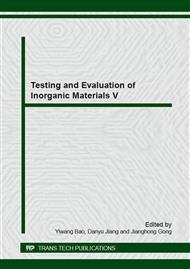[1]
Han Zeng-hu, Tian Jia -wan, Dai Jia-wei, et al., Preparation and mechanical properties of magnetron sputtered CrNx thin films, Journal of Functional Materials, 2002 33(5): 500-502.
Google Scholar
[2]
P.L. Ge, M.D. Bao, H.J. Zhang, K. You, X.P. Liu, Effect of plasma nitriding on adhesion strength of CrTiAlN coatings on H13 steels by closed field unbalanced magnetron sputter ion plating, Surf. Coat. Technol. 2013, 229: 146-150.
DOI: 10.1016/j.surfcoat.2012.08.002
Google Scholar
[3]
Z.L. Wu, J. Lin, J.J. Moore, M.K. Lei. Microstructure, mechanical and tribological properties of Cr–C–N coatings deposited by pulsed closed field unbalanced magnetron sputtering, Surf. Coat. Technol. 2009, 204: 931-935.
DOI: 10.1016/j.surfcoat.2009.04.032
Google Scholar
[4]
J.S. Chen , S.P. Lau, Y.B. Zhang, et al., Deposition of permalloy films by filtered cathodic vacuum arc, Thin Solid Films, 443(2003)115–119.
DOI: 10.1016/s0040-6090(03)01031-9
Google Scholar
[5]
B.J. Chen, X.W. Sun, B.K. Tay, Fabrication of ITO thin films by filtered cathodic vacuum arc deposition, Materials Science and Engineering B, 106(2004)300–304.
DOI: 10.1016/j.mseb.2003.09.046
Google Scholar
[6]
R.L. Boxman, V. Zhitomirsky, B. Alterkop, et al., Recent progress in filtered vacuum arc deposition, Surf. Coat. Technol. 86-87 (1996) 243-253.
DOI: 10.1016/s0257-8972(96)03023-x
Google Scholar
[7]
F. Liu, Y.D. Meng, Zh. X. Ren, et al., Characterization of ZrN flims deposited by ICP enhanced RF magnetron sputtering, Acta Physica Sinica, 2008 57(3) 1796-1801.
DOI: 10.7498/aps.57.1796
Google Scholar
[8]
F. Liu, Y.D. Meng, Zh. X. Ren, et al., Synthesization of ZrN films by inductively coupled plasma assisted RF magnetron sputtering, Chinese Journal of Vacuum Science and Technology, 2007 27(6) 526-530.
Google Scholar
[9]
Q.L. Fan, H.Y. Zhao, L.X. Song, et al., Reactive sputter deposition of nc-TiN/A-Si3N4 nanocomposite films in a magnetized inductively coupled plasma, Journal of Inorganic Materials, 2004 19(5)1080-1086.
Google Scholar


